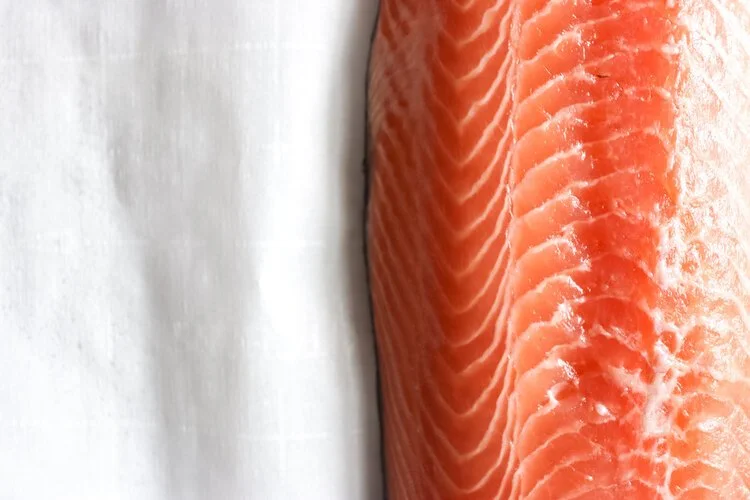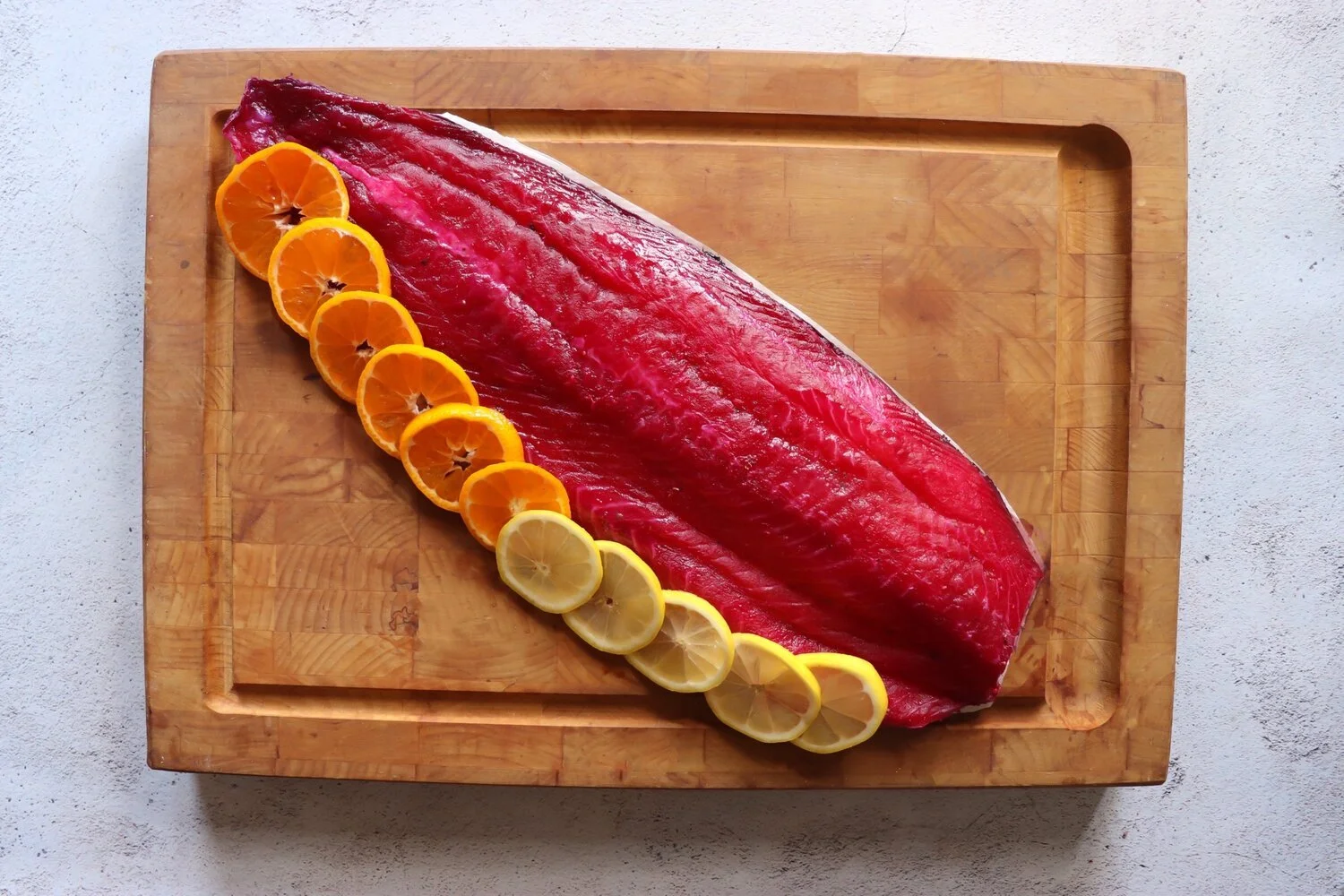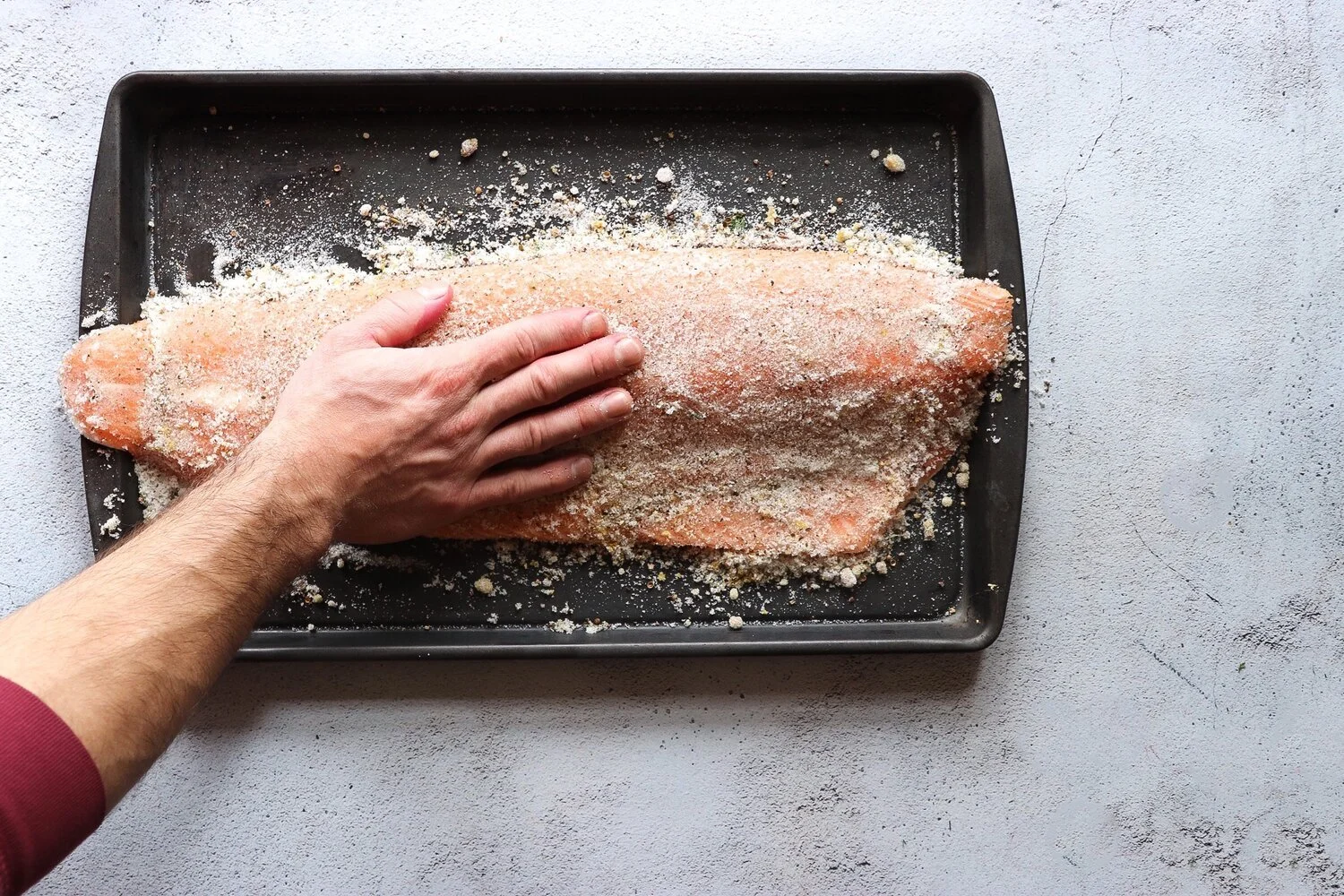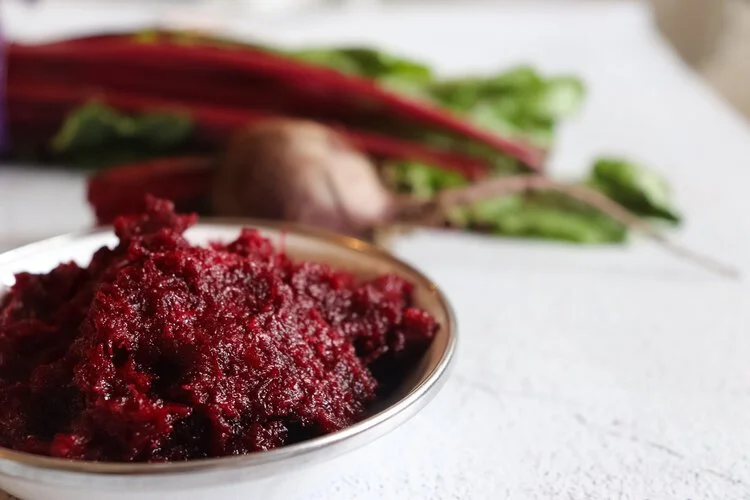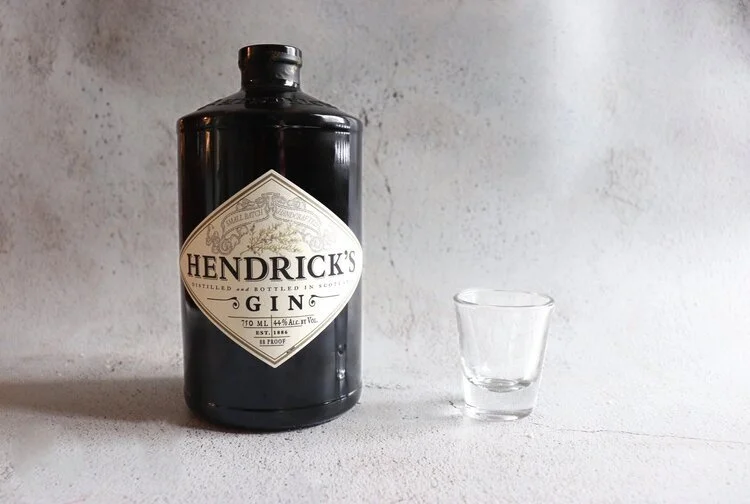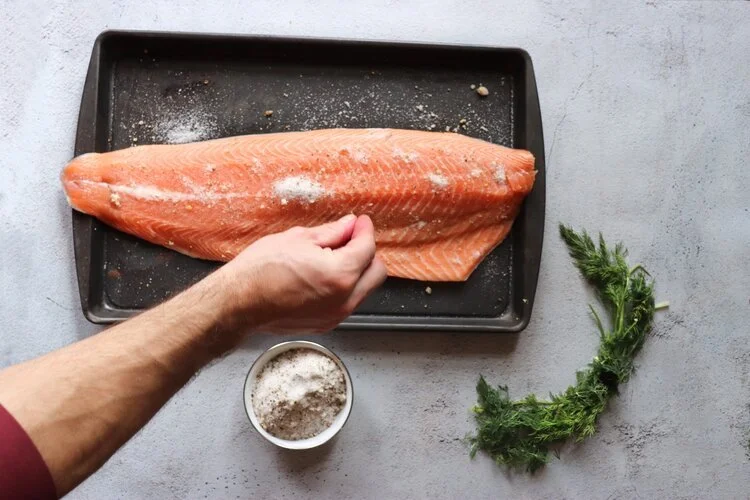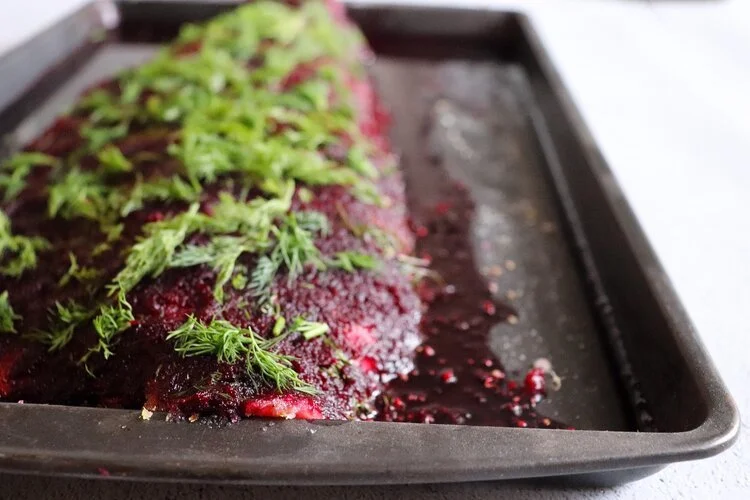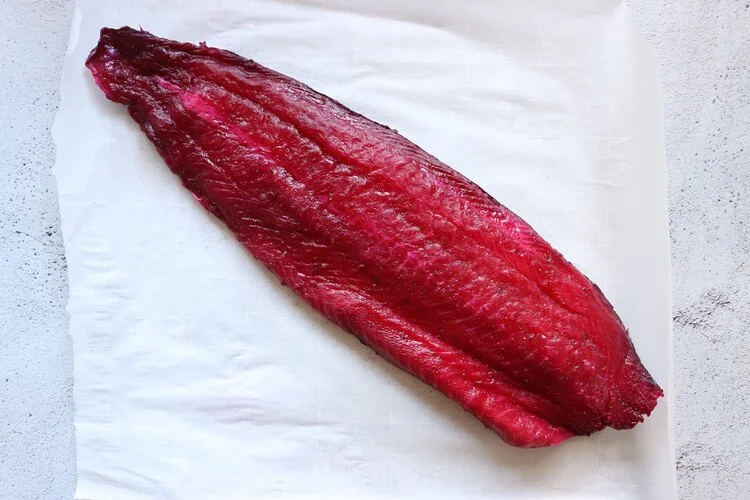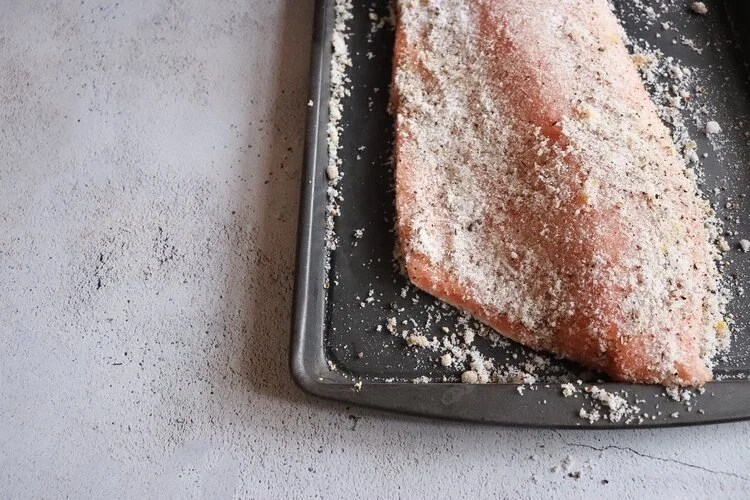Gin and Beetroot Cured Salmon Gravlax
A visually stunning beet cured salmon recipe seasoned with freshly ground spices that is deceptively easy to make, gorgeous to look at, and delicious to eat.
I am obsessed with this visually stunning gin and beet cured salmon gravlax, seasoned with some delicious dill and freshly ground spices. This recipe is deceptively easy to make, gorgeous to look at, and delightful to eat. Gravlax is a Nordic fish dish consisting of salmon that is cured using coarse salt, sugar, dill, and a variety of spices. In its native Scandinavia, gravlax is sliced thinly, and served as an appetizer, typically accompanied by gravlaxsås, a dill mustard sauce, and either rye bread or boiled potatoes.
We cured our salmon with some added gin and beetroot, which imparted a gorgeous magenta hue, and earthy herbaceousness to the salmon. Gravlax bears a slight resemblance to smoked salmon, and thus, we had to give our salmon the brunch board treatment—complete with bagels, chive cream cheese, and crunchy caper berries. Once you see how easy this recipe is to make, and how absolutely delicious it tastes, it is a recipe you will want to make over and over again.
The History of Gravlax
Gravlax is a Nordic fish dish consisting of salmon that is cured using coarse salt, sugar, dill, and a variety of spices. During the Middle Ages, salt was an expensive commodity and it was oftentimes challenging to sell salmon soon after it was caught.[1] Peasants and fishermen developed a unique technique called gräva -lax, which translates from the Swedish word that means “to bury salmon.”[2] Fishermen would encrust a filleted salmon with spices and herbs, and then bury it in a hole in the earth clad in earth and moss above the high-tide line.
Nowadays, the salmon is “buried” in a dry marinade of salt, sugar, and spices, and cured for between twelve to forty-eight hours. As the salmon cures, the natural moisture of the salmon turns the dry spice mixture into a highly-concentrated brine, which, in some Scandinavian dishes, is used as a sauce. Scandinavian countries have adapted the historical recipe, and introduced various spices and herbs into the traditional curing recipe—from dill to honey to local spirits. In fact, in Denmark and Norway, chefs have used beet puree, gin, aquavit, and cognac into their curing concoctions.
What Does Gravlax Taste Like?
Gravlax tastes like a cross between a salmon sashimi (imagine the smooth buttery texture of sashimi with the addition of seasoning from salt and herbs), and a luxurious smoked salmon (minus the smoky flavor).
Smoked salmon and gravlax are actually quite similar in flavor and texture in that they both have a moist, silky texture that is “raw-like”, rather than hard like jerky. But the biggest difference between the two preparations is that smoked salmon is made by smoking raw salmon at a low temperature, which permeates the salmon; gravlax does not have this smoky flavor because it is cured in salt, sugar, and spices.
The Key to the Cure: Salt-to-Sugar Ratio
While this recipe, for the most part, is deceptively easy to make, there is one area of caution . . . over-salting the salmon to death. There is nothing more criminal than miscalculating the amount of salt needed to cure a beautiful sashimi-grade piece of salmon, and absolutely destroying the delicacy of the fish in a sarcophagus of salt.
If you search recipes, you’ll find that both the salt-to-salmon ratio and curing times are all over the place. Some recipes use as little as 6 oz of salt and sugar / 2 lb of salmon, and have curing times that range from 12 hours to 72 hours. The variance is a bit disconcerting.
After making this recipe several times (and achieving varying results) this is the salt-to-sugar-to-salmon ratio I found that delivers and impeccable brightness and acidity to the salmon without overpowering it with salt, or, conversely, under-seasoning the fish.
Equal parts salt + sugar (combined) 50% of the weight of the salmon
Coat 24 hours for lightly cured, 48 hours for medium (this is what I do), and 72 hours for hand cure
One exception to this formula—if you use a piece of salmon smaller than 1 lb, you will need to increase slightly the salt/sugar ratio to the weight of the salmon to ensure there is enough curing mixture to cover the surface area of the salmon.
This recipe ensures that each bite of salmon will have a nice level of salt to so you’ll enjoy eating the fish condiment-free. Similarly, this salt ratio and cure time will ensure that the salmon flesh is not overly-cured and dry, but it ensures it will be delicate, moist, and easily sliceable into thin pieces.
Choosing Your Salmon
PLEASE ensure that you use sashimi-grade salmon. This is crucial from a health-and-safety perspective, and will ensure there are no issues with potential bacteria or parasite issues down the road. Sashimi-grade products in the U.S. are flash frozen to kill any parasites.
I also prefer my salmon to be skin-on for this recipe. While this means that the skin side will be slightly less cured, I find this balances the top portion of the salmon well. Plus, having the skin on makes the finished dish easier to carve.
Before curing the salmon, I rinse the fish and pat it dry with paper towels. I then run my fingers the length of the salmon, down along the middle line, and along the outer edges of the filet, feeling for opaque pin bones. Remove any bones with tweezers or needle-nosed pliers.
A Note on Salt
Salt roughly falls into four categories:
Table salt
Kosher / coarse cooking salt
Flakes
Rock salt
First and foremost – do not, under any circumstances, use table salt or iodized salt for this recipe. Table salt will make the salmon unpleasantly salty. Iodized salt has the potential to react with the curing ingredients and turn the salmon an unattractive shade of brown.
The two best types of salt to use for this recipe are kosher/coarse cooking salt and rock salt. If you are looking for a salmon with a firmer, drier surface (almost akin to a seared scallop or filet). This is because the kosher/coarse salt have finer grains than the rock salt, which allow them to penetrate further into the salmon.
If using kosher/coarse salt, the following is a general guide to cure times:
Medium Cure : 36 hours
Hard Cure : 48 Hours
Rock salt is the preferred type of salt for curing seafood, as it cures the salmon evenly from surface to center.
If using rock salt, the following is a general guide to cure times:
Medium Cure : 36 hours
Hard Cure : 72 Hours
Regardless of whether you use kosher/coarse salt or rock salt, I recommend resting the salmon for approximately 12 hours before serving, after the curing and gin and beetroot mixture have been scraped off the fish. This will allow the saltiness to distribute more evenly throughout the salmon. However, if you do not have the extra time, this certainly will not ruin the recipe, and you will still have a delicious and aesthetically gorgeous piece of cured salmon.
A Note on Curing Times
When curing finfish, there are three main levels of cure:
Light Cure: The exterior of the salmon will have a light magenta hue and will be herbaceous. But the inner layers of the salmon will be sashimi-grade.
Medium Cure: The surface of the salmon will be fairly firm and not too salty; the inside of the salmon is lightly cured and will still retain some moisture (although it will not be raw). Flavor-wise, the salmon will be flavorful enough to eat the slice plain without having to douse the fish in extra seasonings and condiments.
Hard Cure: The surface of the salmon will be quite firm like a soft jerky, and well-seasoned. The inside of the salmon will be firmer and meatier. The only reason I do not prefer the hard cure is that it tends to be a bit salty for my palate, and I find myself squeezing citrus onto the surface to add some brightness to the fish.
Medium Cure : The surface of the salmon will be fairly firm and not too salty; the inside of the salmon is lightly cured and will still retain some moisture (although it will not be raw). Flavor-wise, the salmon will be flavorful enough to eat the slice plain without having to douse the fish in extra seasonings and condiments.
Hard Cure :The surface of the salmon will be quite firm like a soft jerky, and well-seasoned. The inside of the salmon will be firmer and meatier. The only reason I do not prefer the hard cure is that it tends to be a bit salty for my palate, and I find myself squeezing citrus onto the surface to add some brightness to the fish.
Q & A’s About This Dish
Q: Can you make gravlax with salmon that has been frozen?
A: Yes, you can, as long as you use high-quality, sashimi grade salmon. For example, don’t use vacuum-packed salmon form the supermarket, or box packet frozen salmon. My recommendation is if you anticipate preparing this recipe with frozen salmon, ensure you freeze the salmon yourself to -10°F for at least a week, or use commercial frozen salmon from a reputable fish monger.
Q: How long does gravlax keep?
A: Honestly, it depends on how much you cure the salmon. Here are some easy-to-reference recommendations:
- Lightly-Cured Salmon (24 hour cure): Do not keep beyond 36 hours at most
- Medium-Cured Salmon (36-48 hour cure): Do not keep beyond 72 hours at most
- Hard-Cured Salmon (72 hour cure): Do not keep beyond 5 days at most
[1] The Nordic Cookbook, Magnus Nilsson

Gin and Beetroot Cured Salmon Gravlax
Ingredients
Instructions
- Toast those spices. Toast all spices (peppercorns, coriander seeds, and fennel seeds) in a dry, small skillet over medium heat, consistently tossing until fragrant, about 5 minutes. Let cool, then finely grind with either a mortar and pestle, or spice grinder.
- Transfer spices to a bowl, and mix in with the salt, sugar, and lemon zest.
- Just beet it. In a separate bowl, mix together the gin, grated beetroot, grated ginger, and chopped dill until it reaches a paste-like consistency.
- Cover the salmon. Lay the salmon, skin-side down, on a large piece of parchment paper or cheesecloth. Pack the spice cure on both sides of the fish, pressing to adhere. Next, pack the gin and beetroot mixture onto both sides of the salmon, also pressing to adhere.
- The cure. Bring up both sides of the parchment paper / cheesecloth around the salmon as tightly as possible. I recommend further wrapping the salmon tightly with plastic wrap to ensure the mixture does not drip out. Once tightly wrapped, arrange the fillet, flesh-side up, on a large rimmed baking sheet. Rest a slightly smaller rimmed baking sheet or other flat, rimmed vessel, on top of the salmon. If available, I recommend placing an object that weights 2-3 lbs on top of the smaller baking sheet to further weigh down the salmon.
- Place the weighted salmon in the refrigerator for at least 2 days, or up to 5 days, wrapped in plastic.
- The big reveal. Carefully unwrap the salmon. Using a butter knife, scrape off the spice and beetroot cured mixtures, and discard. Do not rinse the salmon.
- Thinly slice, and serve
- Salmon will keep for 1 week in an airtight container in the refrigerator



